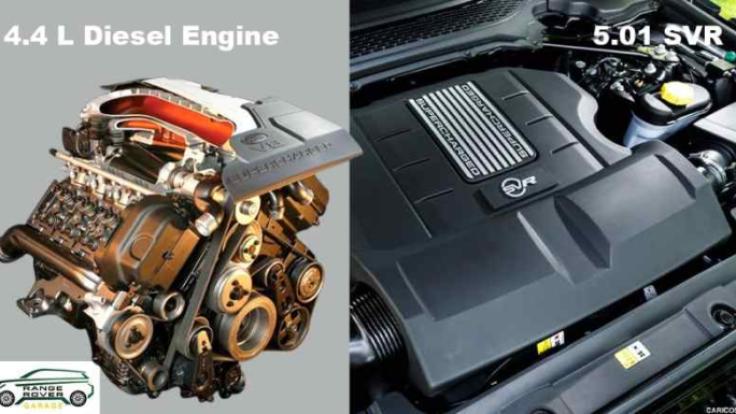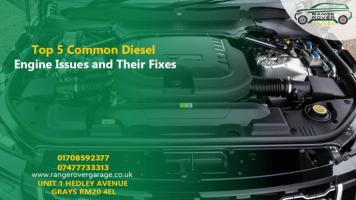4.4 L Diesel Engine and 5.0l SVR Supercharged Features Explained
- Posted on October 17, 2024
- blogs
- By Administrator
- 9251 Views

Jaguar Land Rover has developed the 4.4-litre diesel engine (V8 engine). Range Rover SVR is a luxurious car and it has complicated machinery. Only this engine can support the Range Rover models. The engine is known for its power, torque, and efficiency.
For those looking for a high-performance vehicle, the Range Rover Sport is the best option for them to choose. The engine is specially designed to provide exceptional performance and luxury. Land Rover has developed its high-performance SVR model which is powered by the 4.4-litre diesel engine. The purpose of this Range Rover engine is to produce more power and torque than the standard engine.
The 4.4-litre diesel engine is equipped with two turbochargers. To be precise, it means that it is equipped with two turbochargers, which can raise the degrees of power and torque. It also has other solutions common rail direct injection, variable geometry turbochargers, and selective catalytic reduction. These technologies assist in making the engine perform better and at the same time utilise fewer emissions.
Technical Specifications of the 4.4-liter Diesel Engine Twin-Turbo
The Range Rover SVR engine version of the 4.4-litre diesel engine is somehow different from other standard engines in performance. Land Rover used advanced technologies to increase its power. Torque, and efficiency. Let’s discuss them:
> Engine Code: B57D30O1
> Displacement: 4.4 liters (4395 cc)
> Number of Cylinders: V8
> Bore and Stroke: Bore: 86 mm, Stroke: 88 mm
> Compression Ratio: 16.5:1
> Maximum Power Output: 400 horsepower (298 kW)
> Maximum Torque: 600 lb-ft (813 Nm)
> Fuel Injection System: Common Rail Direct Injection (CRDI), enabling precise control of fuel delivery for improved efficiency and performance.
> Turbochargers: Twin-turbo configuration helps to enhance power delivery and response across a wide RPM range.
> Emission Standards: Compliance with Euro 6 emission standards, particularly Euro 6 which subsequently leads to reduced emission of nitrogen oxides (NOx), and fine particles for ecological responsibility.
How Twin-Turbocharging Works?
Twin-turbocharging includes the use of two turbochargers. Their purpose is to increase the engine's power output and efficiency. Here’s how it works:
Turbocharger Basics: a turbine and a compressor is used in a turbocharger. When the gases exhaust they spin the turbine. When this procedure starts it draws more air and compresses it before entering the SVR car’s engine cylinders.> Twin-Turbo Configuration: Twin turbo itself explains that two turbochargers are involved in this system. These can be configured in various ways:
Parallel Configuration: Each turbocharger is attached to half of the engine’s cylinder number, it provides a quicker response and less lag time. This setup opens up more responsiveness at low revolutions per minute.
Sequential Configuration: Some cars use a small and a big turbocharger; a small turbocharger gives power at a low RPM range while the larger turbo์ส miệng at a high RPM range. This configuration provides the best engine performance throughout the whole RPM range.
When you talk about performance or efficiency twin turbocharging has multiple benefits:
-
It helps to make SUV cars more powerful without affecting the engine. It boosts the horsepower or torque.
-
This makes it possible to achieve smaller delay or lag normally related to turbo-charged range sport v8 engines thus achieving immediate throttle response or spool-up times.
-
Twin-turbo systems enable small engines to produce more power. As a result, you can enjoy fuel efficiency even under partial load conditions.
-
It helps to provide smoother acceleration and more usable power across various driving conditions
-
The proper gas emission system of Range Rover sport SVR engine makes it an environment-friendly vehicle
Moreover, when it comes to comparing the twin-turbocharged engine, there are a variety of specs you must consider:
SVR-Specific Features and Enhancements
-
Range Rover v8 supercharged uses twin turbochargers because this is a luxury car and requires a powerful engine. A single turbo engine is incapable of handling the Range Rover. Twin-turbo boosts the performance of the car. This adjustment allows the engine Range Rover SVR to generate more horsepower and torque.
-
Land Rover introduces a less restrictive exhaust system in the SVR Range Rover sport. this helps to engine work properly to exhaust gases efficiently. This modification improves turbocharger response and overall engine performance.
-
Larger and more efficient intercoolers are installed in order to reduce intake air temperatures even further. This guarantees that the engine receives pliable, cooler air for burning resulting in improvement in power and efficiency.
-
The fuel injection system is also optimised for higher flow rates to enable high power output of the machine. This makes it possible to accurately measure fuel even during high rpm levels or even low temperatures.
-
The ECU is flashed with performance maps that restore standard air-fuel ratios and ignition maps for better response under various load conditions.
High-Performance Components and Materials
-
The SVR engine uses forged pistons crankshafts or connecting rods. They help to improve the durability or strength of the Range Rover SVR engine. The purpose of using these components help the engine to withstand extreme heat or other situations. Land Rover has designed the cylinder heads to maintain the airflow with larger valves and optimized porting for better breathing and enhanced combustion efficiency.
-
range sport v8 engine is designed using lightweight materials such as aluminium alloys in the engine block and components. This lightweight material contributes to overall vehicle weight reduction while maintaining structural integrity.
Overall, These features help the SVR car to maximize its speed, and performance through advanced modifications, high-quality materials, and precise calibration. These all help in creating a truly high-performance engine tailored for the discerning enthusiast.
Performance and Driving Experience
Acceleration and Top Speed Figures
-
Acceleration: The specific SVR model also comes equipped with the 4.4-litre diesel engine which will allow reaching the speed of 60mph in around 4.5 seconds. This kind of speed customization is due to the high output torque of the engine and the effectiveness of the twin turbos.
-
Top Speed: The speed is restricted to around 250 km/h through the limiter installed as standard in the car. This is a typical constraint on powerful cars because performance always must be moderate from a safety viewpoint.
-
Power-to-Weight Ratio: At a power-to-weight ratio of about 200 horsepower per ton the Range Rover SVR can reach high speeds, accelerate and overtake other cars on the road.
Fuel Economy and Emissions Data
-
Fuel Economy: Range Rover SVR provides fuel economy of around 25 mpg (10.6 L/100 km) in combined driving conditions. This figure explains the balance between performance and efficiency. This is typical for modern high-performance diesel engines.
-
Emissions Data: The engine complies with Euro 6 emission standards. It produces approximately 200 g/km of CO2. This efficient combustion process minimizes harmful emissions at the same time never compromises high performance.
-
NOx and Particulate Matter: selective catalytic reduction (SCR) and diesel particulate filters (DPF) cut the emission of NOx and particulate matter creating a lesser impact on the environment.
Driving Dynamics and Handling Characteristics
-
Range Rover Sport SVR provides an air suspension system which can adjust to all driving conditions. This setup enhances ride comfort while improving cornering stability and responsiveness.
-
It steers with electric power assistance and direction, which is geared for a precise feeling with the road, making the driver feel more in control, especially at high speeds.
-
The new sophisticated all-wheel drive (AWD) system makes power delivery to all four wheels, which means optimum grip and balance, especially in adverse terrains. It also assists in retaining the command during power and through the turn.
Comparison to Other High-Performance Diesel Engines
-
Power Output: When you compare your Range Rover engine with your competitors like the BMW 4.0-liter V8 diesel, the SVR’s 4.4-litre engine offers similar power figures but it provides a higher torque output which makes it more suitable for towing and off-road performance.
-
Turbocharging Technology: In other vehicles, single turbocharged engines are being used but there is a major difference that keeps this vehicle apart from others in its twin-turbo design. This gives it an edge in throttle response and power delivery, especially in low- and mid-range RPMs.
-
Weight Distribution: The weight distribution is great in SVR. Its lightweight construction and engine placement offer better weight distribution which is difficult to find in competitors like the Audi SQ7. This lightweight facility helps to improve handling and cornering dynamics.
You will get what you are expecting from your SVR Range Rover. This new model is famous for delivering impressive performance metrics, efficient fuel economy, and engaging driving dynamics.
These facilities help the vehicle to maintain its position in its competitor in the high-performance diesel market. Its lightweight twin-turbo engine ensures a thrilling driving experience without compromising on practicality or environmental considerations.
Maintenance and Servicing
Recommended Service Intervals
-
Oil Change: To change the engine oil every 10,000 miles (16,000 km) or annually is necessary for the engine’s health. This helps to save the engine from turning to scrap.
-
Air Filter Replacement: It is essential to check the engine air filter. proper inspection and replacement every 20,000 to 30,000 miles (32,000 to 48,000 km) is required to ensure proper airflow and engine efficiency.
-
Fuel Filter Change: Replacing the fuel filter is also important every 30,000 miles (48,000 km) to maintain fuel quality and prevent impurities from affecting engine performance.
-
Brake Fluid and Coolant Service: Brake fluid and coolant inspection is one of the most essential tasks. Ensuring effective braking and cooling system performance try to inspect them timely.
Final Thoughts
The new 4.4-litre diesel engine, Range Rover svr price is perfect for the UK market owing to the diesel preference for efficiency & torque on variable road conditions. Because it offers reasonable performance, reliable handling, and meets very high emission standards, it can be used both in city traffic and in rural areas.
Furthermore, with its lavish equipment list and Ernst & Young “green technologies”, the Range Rover SVR targets the client demands. All in all the automaker successfully positions the SVR as a formidable contender in the hi-performance diesel segments. This is meant for the needs of enthusiastic UK buyer.

